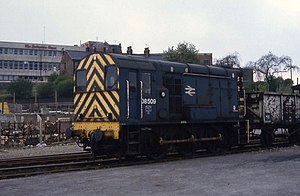Class 08

08509 in Rail Blue livery at Chesterfield Goods Yard
|
|||||||||||||||||||||||||||||||||||||
|
|||||||||||||||||||||||||||||||||||||
|
|||||||||||||||||||||||||||||||||||||
|
|||||||||||||||||||||||||||||||||||||
|
|||||||||||||||||||||||||||||||||||||
| Type and origin | |
|---|---|
| Power type | Diesel-electric |
| Builder | British Railways: Derby Works, Crewe Works, Darlington Works, Doncaster Works and Horwich Works. |
| Build date | 1952–1962 |
| Total produced | 996 |
| Specifications | |
|---|---|
| Configuration: |
|
| • Whyte | 0-6-0 |
| • UIC | C |
| Wheel diameter | 4 ft 6 in (1.372 m) |
| Wheelbase | 11 ft 6 in (3.505 m) |
| Length | 29 ft 3 in (8.92 m) |
| Width | 8 ft 6 in (2.591 m) |
| Height | 12 ft 8 5⁄8 in (3.877 m) 11 ft 9 5⁄8 in (3.597 m) (08/9) |
| Loco weight | 49.6 long tons (50.4 t; 55.6 short tons) to 51 long tons (51.8 t; 57.1 short tons) |
| Fuel capacity | 668 imp gal (3,040 l; 802 US gal) |
| Prime mover | English Electric 6KT |
| Generator | DC |
| Traction motors | DC English Electric 506, 2 off |
| Transmission | Diesel-electric transmission double reduction drive |
| MU working | Not originally fitted, some retrofitted with type ★ Blue Star |
| Train heating | None |
| Train brakes | Vacuum, later Air & Vacuum or Air only |
| Performance figures | |
|---|---|
| Maximum speed | 15 mph (24 km/h) or 20 mph (32 km/h) |
| Power output | Engine: 350 hp (261 kW) |
| Tractive effort | Maximum: 35,000 lbf (160 kN) |
| Brakeforce | 19 long tons-force (190 kN) |
| Career | |
|---|---|
| Operators | British Railways |
| Numbers | 13000–13116, 13127–13136, 13167–13365; later: D3000–D3116, D3127–D3136, D3167–D3438, D3454–D3472, D3503–D3611, D3652–D3664, D3672–D3718, D3722–D4048, D4095–D4098, D4115–D4192; later 08001–08958 |
| Axle load class | Route availability 5 or 6 (see text) |
The British Rail (BR) Class 08 is a class of diesel-electric shunting locomotive. The pioneer locomotive, number 13000, was built in 1952 although it did not enter service until 1953. Production continued until 1962; 996 locomotives were produced, making it the most numerous of all British locomotive classes.
As the standard BR general-purpose diesel shunter, almost any duty requiring shunting would involve a Class 08. The class became a familiar sight at many major stations and freight yards. Since their introduction, though, the nature of rail traffic in Britain has changed considerably. Freight trains are now mostly fixed rakes of wagons, and passenger trains are mostly multiple units, neither requiring the attention of a shunting locomotive. Consequently, a large proportion of the class has been withdrawn from mainline use and stored, scrapped, exported or sold to industrial or heritage railways.
As of 2011, around 100 locomotives remain working on industrial sidings and on the main British network. On heritage railways, they have become common, appearing on many of the preserved standard-gauge lines in Britain, with over 60 preserved including the first one built.
The Class 08 design was based on the LMS 12033 series (later TOPS Class 11) design. There were also 26 of the near-identical but higher-geared Class 09, and 171 similar locomotives fitted with different engines and transmissions (some of which became Class 10), which together brought the total number of outwardly-similar machines to 1193.
The locomotives were built at the BR Works of Crewe, Darlington, Derby, Doncaster and Horwich between 1952 and 1962.
In 1985, three locomotives were reduced in height for use on the Burry Port and Gwendraeth Valley Railway in south west Wales, and became Class 08/9. The remainder of the class were reclassified as sub-class 08/0. A further two locomotives were converted to 08/9 in 1987.
...
Wikipedia
